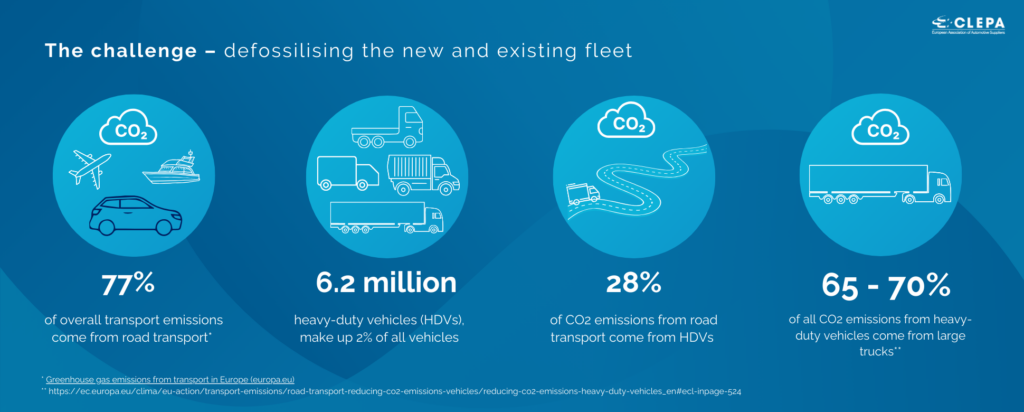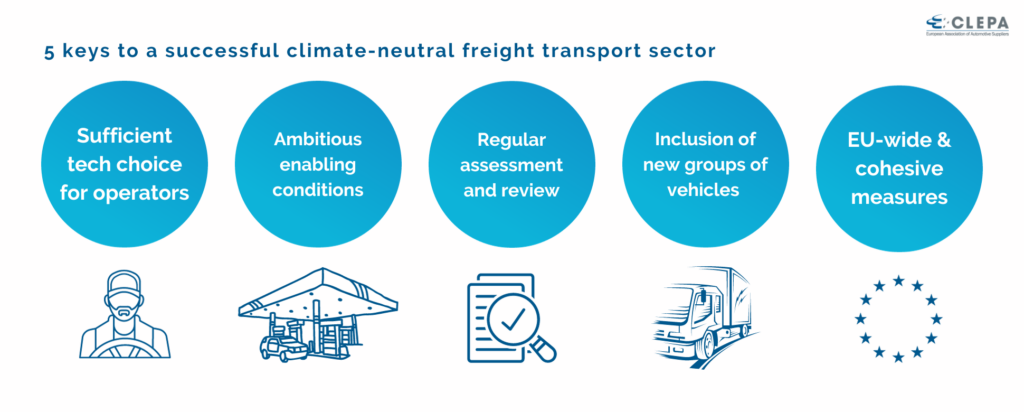The challenge – defossilising the new and existing fleet
Heavy-duty vehicles (HDVs) are crucial to our daily lives. They are the “workhorses” of modern society, enabling the movement of goods, materials and services that sustain our social fabric. They contribute significantly to the prosperity of the Single Market, both local and regional economies, and our overall quality of life.
There are currently 6.2 million trucks circulating on EU roads, with a staggering 96.4% running on diesel. While the transition to electromobility is underway, diesel continues to dominate, powering 94.8% of newly registered trucks in 20211. Although HDVs only account for about 2% of all vehicles, they are responsible for 28% of CO2 from road transport2, with heavy trucks accounting for the lion’s share, about 70%, of overall CO2 emissions3.
Trucks are not cars – every truck has a mission
Trucks are complex machines requiring considerable investment. When it comes to freight transport, various technologies are needed to meet the requirements of each use-case. From medium-sized trailers to tank trucks, from vehicles driving up mountains carrying heavy loads to urban deliveries, HDVs must adapt and integrate different clean tech solutions that optimise efficiency, safety, and environmental sustainability across this diverse spectrum of logistics challenges.
The cost considerations for commercial HDVs are of significant importance. While the International Council on Clean Transportation (ICCT) indicates that battery electric trucks (BETs) and diesel trucks can reach cost parity prior to 2030 (with a range of 2024-2029 depending on the country), a closer examination of factors including battery expenses, charging infrastructure, truck and battery resale values, among others, reveals an approximate discrepancy of €70,000-98,000. This variance extends the timeline for total cost of ownership (TCO) parity, shifting it to a window between 2029 and 2035.
The benefits of #TruckDiversity
Auto suppliers support a regulatory framework for HDV CO2 standards that empowers innovation and allows operators to choose the tech that best fits each use-case. To accelerate emissions reductions efficiently and cost-effectively, policymakers should embrace technology diversity for trucks. Clean trucks can utilise hydrogen combustion, sustainable renewable fuels, or electrification, in combination with other technologies such as eTrailers, offering tailored options based on energy availability and cost, truck mission and load.
A massive switch in the near future from the 1,500km driving autonomy of 40-tonne vehicles propelled by combustion to an electric vehicle autonomy of 300km, with uncertain charging infrastructure and grid availability, will pose serious risks, particularly on long-haul routes.
Mandating a rapid shift to electromobility in the freight sector also requires enabling conditions to be met, such as securing critical raw materials in Europe, affordable renewable energy, and an adequate refuelling and recharging infrastructure. Overall, the lack of sufficient enabling conditions means that even the existing target (30% reduction by 2030) will be difficult to achieve. To meet the proposed CO2 targets for 2030 (45%), 2035 (65%) and 2040 (90%), substantial additional investments are required to realise the necessary enabling conditions.
Additionally, to understand the true ecological impact and sustainability of a truck it must be viewed in the context of its whole life cycle. Climate regulations are successful only when they consider all emissions associated with the vehicle production & use, rather than just tailpipe-emissions. A lifecycle approach, starting with WtW is essential to achieving overall atmospheric CO2 goals effectively.
Industry leaders explain the benefits of #TruckDiversity




